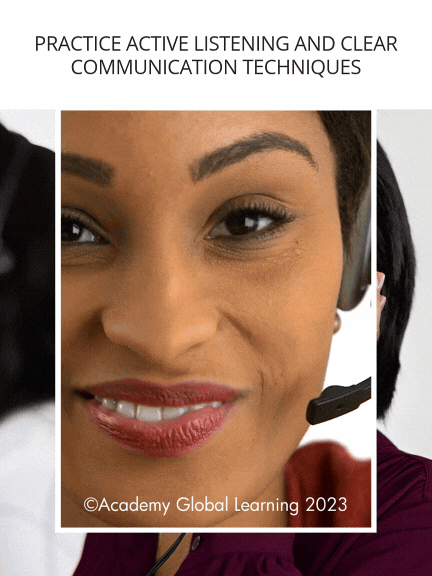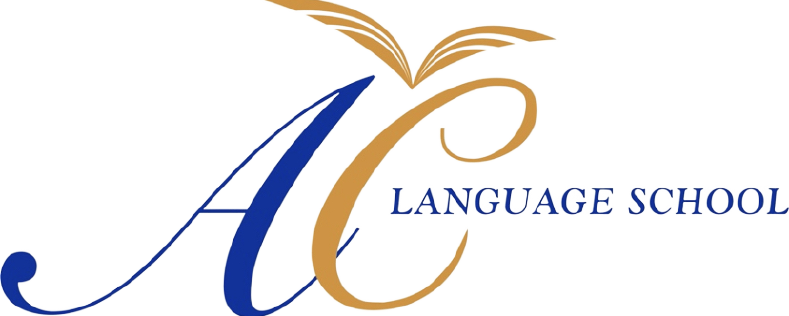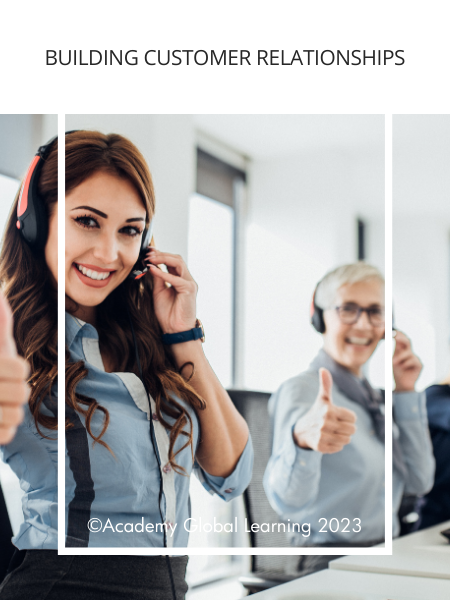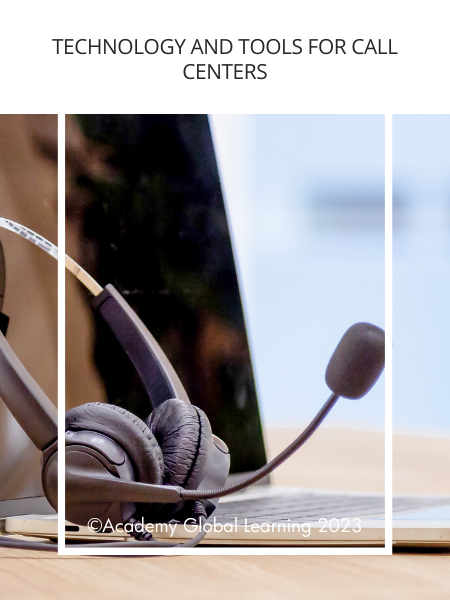

This book developed by ©Academy Global Learning 2024
All rights reserved under ©Academy Global Learning 2024. No part of this publication may be reproduced, stored in a retrieval system, or transmitted in any form or by any means, electronic, mechanical, photocopying, recording, or otherwise, without the prior written permission of the copyright owner.
Designed By:
Christian Alas
Created and illustrated By:
Angelo Romero

Practice Active Listening and Clear Communication Techniques
Effective communication lies at the heart of great customer service. In a call center environment, how you communicate with customers can make or break the relationship. Active listening and clear communication are essential skills that ensure you not only understand the customer’s needs but also respond in a way that builds trust and resolves issues efficiently. By practicing these skills, call center agents can foster better relationships, provide accurate solutions, and enhance customer satisfaction.

– 2 –
Active Listening Techniques
Active listening is a skill that requires focus, engagement, and empathy. It involves more than just hearing the words the customer is saying—it’s about understanding their emotions, concerns, and expectations. Active listening helps you gather the right information to respond effectively and make the customer feel heard.
Here are key active listening techniques:
• Pay full attention: Give the customer your undivided focus. Eliminate distractions and show interest through verbal and non-verbal cues. For example, saying “I see” or “That makes sense” shows that you’re engaged.
• Ask clarifying questions: If something is unclear, ask the customer for more details. This demonstrates that you are committed to understanding their needs and provides the information necessary to offer the best solution.
• Paraphrase and summarize: Restate the customer’s concerns in your own words to confirm that you have understood them correctly. For example, “So, if I understand correctly, you’re asking for a refund due to a billing error.”
Clear Communication
Clear communication is about conveying your message in a way that is straightforward, concise, and easy to understand. It helps prevent misunderstandings and ensures that customers feel confident in the solutions you offer.
– 3 –
To practice clear communication:
• Use simple language: Avoid jargon or overly complex terms unless absolutely necessary. Customers appreciate when you speak in a way that is easy to follow and non-technical.
• Be concise: Customers value efficiency, so ensure that your responses are direct and to the point. Avoid rambling or offering unnecessary information.
• Match tone and formality: Adjust your tone and level of formality based on the customer’s language and demeanor. If the customer is casual, adopt a more relaxed tone; if they are formal, ensure you match their level of professionalism.
Barriers to Effective Communication
While striving for clarity and engagement, several barriers can hinder communication:
• Distractions: External factors, such as background noise or multitasking, can take your attention away from the customer. Minimizing distractions ensures that you can focus entirely on their needs.
• Assumptions: Making assumptions about a customer’s issue can lead to misunderstandings. Always seek to understand the customer’s situation thoroughly before providing a response.
• Negative language or tone: Using negative language can escalate frustration. Focus on using positive language to reassure the customer, even in challenging situations.
– 4 –
By mastering active listening and clear communication techniques, you will improve your ability to resolve customer issues, prevent misunderstandings, and build stronger customer relationships. These skills are vital in ensuring that customers feel valued, heard, and respected, leading to a more productive and satisfying experience for everyone involved.
Key Takeaways:
• Active listening is about engaging with the customer to understand both their words and emotions.
• Clear communication helps prevent misunderstandings and ensures that the customer receives accurate and helpful information.
• Overcoming barriers such as distractions, assumptions, and negative language is key to effective communication.
By practicing these skills, you will build a strong foundation for providing excellent customer service and handling even the most complex customer inquiries with confidence and professionalism.

– 5 –



 ESL for call centers | Introduction to Customer Service: The Cornerstone of Business Success
ESL for call centers | Introduction to Customer Service: The Cornerstone of Business Success  ESL for call centers | Building Customer Relationships
ESL for call centers | Building Customer Relationships  ESL for call centers | Problem-Solving in Customer Service
ESL for call centers | Problem-Solving in Customer Service  ESL for call centers | Technology and Tools for Call Centers
ESL for call centers | Technology and Tools for Call Centers  ESL for call centers | Handling Complaints and Difficult Customers
ESL for call centers | Handling Complaints and Difficult Customers  ESL for call centers | Professional Development and Career Growth
ESL for call centers | Professional Development and Career Growth  ESL for call centers | Self-Care and Stress Management
ESL for call centers | Self-Care and Stress Management  ESL for call centers | Professionalism in the Call Center
ESL for call centers | Professionalism in the Call Center